 Tablets and smart phones have launched a culture of portable reading. Clients today review opinion letters on iPhones, for example. And now that courts manage documents electronically, judicial clerks – and even judges – may read your brief on a Kindle Fire. Because screen readers are multitasking – gathering information amidst the lure of email, Facebook, Instagram and kitten videos – lawyers must adapt their writing to continue engaging and persuading readers.
Tablets and smart phones have launched a culture of portable reading. Clients today review opinion letters on iPhones, for example. And now that courts manage documents electronically, judicial clerks – and even judges – may read your brief on a Kindle Fire. Because screen readers are multitasking – gathering information amidst the lure of email, Facebook, Instagram and kitten videos – lawyers must adapt their writing to continue engaging and persuading readers.
Research shows that screen readers exhibit certain traits. Most notably, they read quickly and in short bursts. They’re likely to skim, focusing primarily on headings and the first sentences of paragraphs. They also follow what’s called the F-pattern – demonstrating a top-left preference – when attacking a screen, bobbing up and down the left side searching for structure.
To leverage your screen reader’s habits, adapt both the substance and cosmetics of legal writing. First, break text into smaller segments. Accept that you reader is likely to skim and therefore make it easy: provide frequent paragraph breaks and insert bullet points for examples. Construct powerful, declarative topic sentences: state your conclusions definitively at the outset of paragraphs and then follow up with support.
Because screen readers crave structure, liberally use headings for key points and to frame your argument. For example, don’t just write “Statute of Limitations” for a heading. Rather, write “Plaintiff’s Case Should Be Dismissed Because the Alleged Harm Occurred 17 Years Ago – Nine Years Beyond the Statute of Limitations.” at way, if readers review only the headings, your position will still be logical and clear.
Finally, depending on the program you use, consider embedding the ability to bookmark and hyperlink to cases, exhibits and other supplemental information, which will help readers keep their place as they come in and out of your document.
About the author:




0 comments on “Legal Writing Tip: Writing for Mobile”